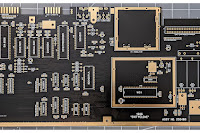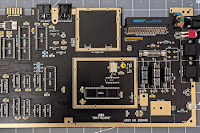Ok, it's been several months since the last update and a lot has changed. First, let's recap.
In the first part of this series in which I redesign my JaF64 RF Modulator replacement to become the all new JaF Sandwich I explain why the hell I would want to add an archaic RCA Jack to my design and this can be summarised in one word: LumaCode. In the second part I dedicate some time to dealing with retrofitting the design into my reproduction C64C case and begin to think about adding the ability to deal with experimental LumaCode from the Kawari Mini (Randy Rossi's impressive VIC-II replacement). In the third part I play around with Kawari Mini LumaCode and establish my prototype board works just fine, but that there are issues with the Kawari Mini's LumaCode. In part four I deal with adding the daughter-board to the JaF Sandwich, and explain my continually infuriating problems trying to get the LumaCode from the Kawari Mini to work. This brings us up-to-date: I had a design that functioned exactly as planned, I just needed to finalise the vertical positioning of the RCA Jack and new boards had been ordered.
But. I had a rethink (crowd slaps forehead in unison).
I was messing about with the VICIIdizer and the Kawari Mini again (yes, I know I said I was putting it on hiatus but it nagged the hell out of me) and it very quickly became apparent that constantly dismantling the JaF Sandwich to change the jumpers was an irritatingly poor design choice. In my defence, when I first designed it, I didn't think I would be chopping and changing the video source all that much, but at the moment I am, and dismantling the JaF Sandwich was a pain. So. I redesigned the boards yet again, this time to accommodate a DIP Switch and remove those pesky jumpers. Et voilà:
This is so much better. Now I just need to remember which switch does what. If only there was some way to record this to jog my addled memory...

Importantly, and the whole reason I added the daughter-board in the first place was to position the RCA Jack nearer to the centre of the corresponding case hole. The daughterboard perfectly takes care of vertical positioning, however if when soldering the RCA Jack I've failed to perfectly align it, then horizontal positioning can be less than stellar. With that in mind, let's see how it looks:
That's about as close to central as I'm ever going to get. Remember, if perfectly central there would only be a 1.87mm gap all round the jack. What you are seeing here is a misalignment of about a third of a millimetre. I can live with that. The RCA cable fits nicely and doesn't hit the hole edges; that was the crucial part. That daughter-board is such a ball-ache I'm really stoked it worked out.
Now, most importantly of all. Does it work?
Course it does! Here's a capture of the Wonderland XII Demo by Censor Design via S-Video (from an original 6569R5 VIC-II chip) and upscaled via a cheap HDMI upscaler. This is using the chroma and luma/sync circuitry on the JaF Sandwich. Audio has been deliberately removed:
Because I generally use a Kawari Mini VIC-II replacement, here's the same demo using the S-Video generated by that:
And here's a capture of the same demo using the VICIIdizer through the RGBtoHDMI (no audio). This is using the simple passthrough on the JaF Sandwich:
And here's a capture of the same demo again using the Kawari Mini outputting LumaCode and passing through the JaF Sandwich via the incorporated voltage divider. Once again, there is no audio in this sample:
As you can see, via all four methods utilised to get a video signal, picture quality is just about as good as it's going to get and so that clinches it: as of now, the JaF Sandwich becomes my RF Modulator replacement of choice and takes permanent residence on both my 250466 SixtyClone boards.
I am frequently wrong however and if building the JaF Sandwich feels like a good wheeze, then I've written a full build guide, which includes the Bill Of Materials and all the necessary Gerber files which are available free of charge for non-commercial use.
Now, I don't want to put you off, but please bear in mind:
- It's really, really expensive. By the time you've bought the minimum quantity of boards, components and paid for shipping you could easily have bought a cheaper, ready made and perfectly good RF Modulator replacement elsewhere, albeit one without the same functionality. The total unit cost of this final revision for me was 26.35 GBP (so 33.30 USD or 31.11 EUR) in April 2024, excluding shipping. The total cost (factoring in everything) is significantly more than that. Figure around 150 GBP (189.56 USD or 177.12 EUR) to fully populate the minimum quantity of boards, shipped.
- You obviously have to source and solder all the components yourself. Though the BOM will help with the former.
- Whilst it works perfectly for my needs, it may not meet yours, for example:
- It might not work on your C64 or clone board
- It might not fit in your C64 case
- I won't be providing any technical support. With a full time job, family and other interests my life is full and happy and I wont make myself miserable fixing other people's problems. Besides, the JaF Sandwich works perfectly for me; if you can't get it to work, that's on you.
- I absolutely will not ever build and sell pre-built versions. I do not have the space or riches to store stock, or the time to build on demand. You're totally on your own.
- Dear PickledLight, can you just add [insert suggestion here]? No. Hell no.
If none of that phases you and you are successful in building one, and if you can be remotely bothered, please drop me an email and show off your efforts with a picture or two.









